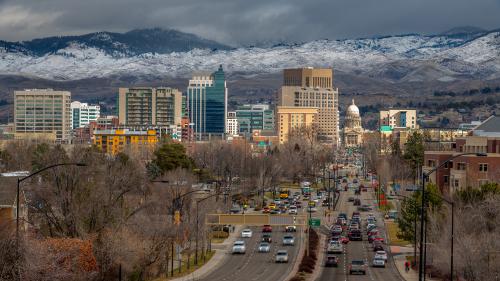Over one-fifth of Americans are directly employed in retail and hospitality, including stores, bars and restaurants, tourism, and entertainment. That’s more than 32 million people working in an industry that’s currently being hammered by widespread closures and layoffs due to COVID-19.
There are a few bright spots in these categories—grocery stores, for example, which are staffing up to respond to the crisis. But the vast majority of these businesses and workers are facing existential calamity.
This is akin to an “evolutionary bottleneck,” when most living members of a species die and adaptive mutations flourish. Just as in nature, a bottleneck will wreak havoc on our retail ecosystem—and we might not like all the mutations that emerge, or the loss of the stores, products, and restaurants we are used to relying on.
The nature of the coronavirus crisis means that certain establishments will face the bottleneck first, which will have reverberating effects across local economies and municipal budgets. But there are steps we can take to ensure our neighborhood shops and their employees endure. The fate of retail is inextricably entwined with the lives of our cities, and all of us as well.
The first hit is to bars, restaurants, and tourism
As of March 23, 38 states and select counties in Arizona, Kansas, Montana, Nebraska, and Missouri have either completely closed bars and restaurants or limited them to takeout/delivery only, in order to enforce social distancing.

The Las Vegas Strip is closed. There is no skiing in Vail. JazzFest in New Orleans is postponed. The coronavirus crisis has already triggered mass unemployment, and the worst isn’t over—the leisure and hospitality sector employs 11.1% of all American nonfarm workers. This will have downstream effects for the next stage of the bottleneck.
The second hit is to retail trade and suppliers
Restaurants and tourists are an essential part of the retail landscape. Most retail stores rely on foot traffic to generate business, and when people aren’t going out to eat or vacation, they aren’t perusing the wares at mom-and-pop shops either. While online shopping can pick up some slack, 88.6% of retail sales were still at brick-and-mortar stores as of the last quarter of 2019. Retailers are staring down a massive slump in business both because people aren’t going out and because laid-off workers don’t have money to spend.
This pain is already spreading down the supply chain. Sysco, the restaurant supplier, saw a stock drop of 20%. Apparel manufacturers are seeing orders canceled. The entire retail world is going to face a tremendous setback from COVID-19.
The third hit is to local and state government revenues
Laid-off workers don’t pay income taxes and don’t shop. Closed bars and restaurants aren’t paying sales taxes. Tourists aren’t paying taxes on rental cars or hotel occupancy. Governments are facing the loss of this revenue at the same time they urgently need resources to respond to COVID-19.
The Urban Institute-Brookings Institution Tax Policy Center reports that sales taxes composed 18.4% of state and local general fund revenue in 2017. There are already signs of future widespread austerity measures in local and state budgeting as this crisis unfolds. When this happened during the Great Recession, even a massive federal bailout was not enough to prevent big cuts to local education, health, and social services.
How to slow the retail bottleneck
Main Street businesses and their suppliers need relief. Writing for the Economic Innovation Group, Adam Ozimek and John Lettieri point out that the COVID-19 crisis will be particularly hard on new small businesses formed during the recovery from the Great Recession. New businesses are the most likely to have debt and will quickly head toward bankruptcy without intervention. They propose a massive, no-interest, long-term loan program to give businesses instant liquidity and decades to pay these loans back.
Brookings’s Joseph Parilla and Reniya Dinkins have rounded up the speedy, creative interventions that cities and states are deploying to help small businesses and workers. Meanwhile, the British government has acted much faster, rolling out grants, no-interest loans, payroll support, and paid sick leave. These ideas can be spread and scaled.
The $349 billion loan program that is part of the federal stimulus package currently under consideration includes some of these ideas. The House of Representatives bill funds private-sector loans guaranteed through the Small Business Administration. However, it is dwarfed by the proposal for a $500 billion Exchange Stabilization Fund administered by the Treasury Department and shared by both corporations and state and local governments. However, the small business loan program in this proposal is not large enough, and the Small Business Administration will likely not have the administrative capacity to get these loans out as quickly as is necessary. Additionally, state and local governments should not be sharing the same relief pool as corporations—they need their own independent source of funding to make it through this crisis.
What the other side of the bottleneck looks like
Many have been stunned by the speed with which the COVID-19 pandemic became not just a public health crisis but an economic one, too. Leisure/hospitality and retail businesses are integral to our economy, and provide the most common jobs in the United States. The current moment is a sobering bit of truth about the fragility of small businesses in these sectors, and the vulnerability of their workers. As we recover from COVID-19, there are important lessons we can use to prepare for the future:
- Profit-sharing leases can help small businesses in tougher times. These leases usually take the form of a modest base rent that switches to a percentage of gross annual revenue after a breakpoint (for example, $15/square foot per month, or 5% of gross revenue, whichever is higher). These leases give retailers and restauranteurs the flexibility to survive lean times and invest the landlord in the tenant’s success. Retailers with this flexibility are more resilient and have more capacity to look out for their workers and suppliers.
- Place-based governance builds resilience. When each business is on their own, it is easy to be swept away by a tidal wave like COVID-19. Place-based governance organizations such as Main Streets and business improvement districts can enable collective action to improve shared spaces, foster business mentoring and relationships, promote destinations, and respond to crises (for example, compiling lists of community resources or restaurants open for takeout).
- COVID-19 will accelerate the convergence and hybridization of conventional retail business models. Just as grocery stores are increasingly selling prepared foods or doubling as coffee shops and bars, restauranteurs are experimenting with new formats including food halls, trucks, and markets, as well as multiple ways to sell their product, such as app-based delivery. Many of these innovations are directed at changing the nature of work in the food service industry, which will alter the opportunities available and the skills required.
- Retailers and their suppliers were already in the middle of multiple industry-wide paradigm shifts. Margins are shrinking and business closures are rising. Without a massive intervention, the pandemic crisis will accelerate these trends, especially online shopping. This will consolidate the grip that corporate retailers such as Amazon, Walmart, and Target have on the trade, and push out what small businesses are left.
Retail and restaurants have been subjected to evolutionary pressure for years now, resulting in innovation on the part of landlords, storefronts, and suppliers. Embracing these ideas will help places weather this pandemic and future crises. But we also need a rapid public-sector response directed at small businesses, or COVID-19 will force that evolutionary bottleneck, resulting in mass unemployment, the emergence of retail oligopolies, and a drastically altered Main Street.






Commentary
COVID-19 will upend retail, but there are steps we can take to save it
March 24, 2020